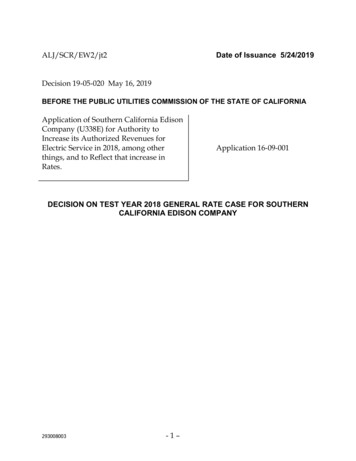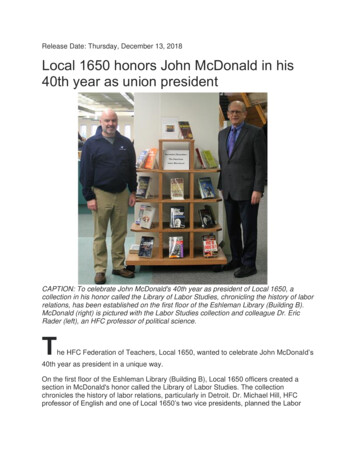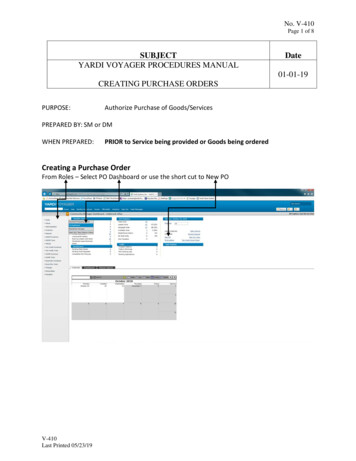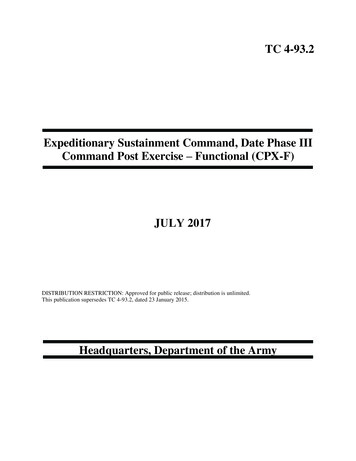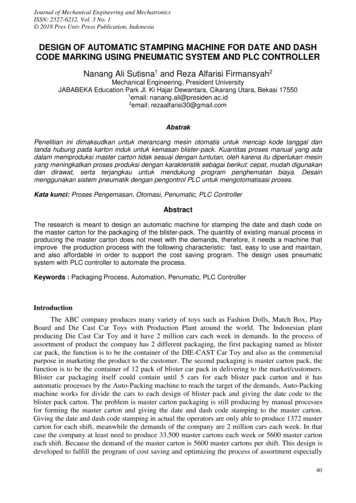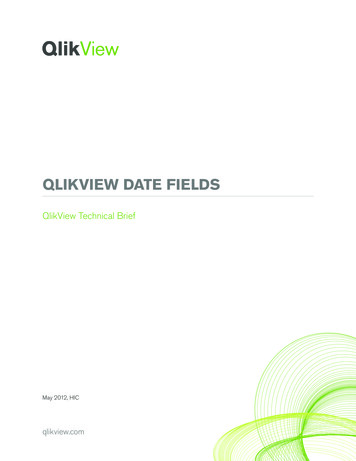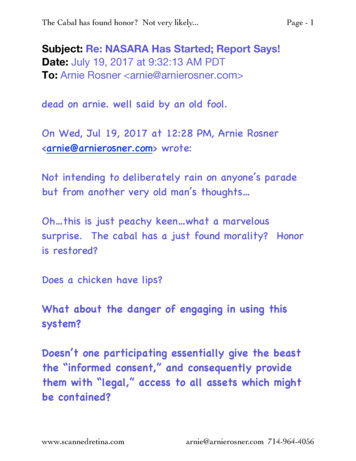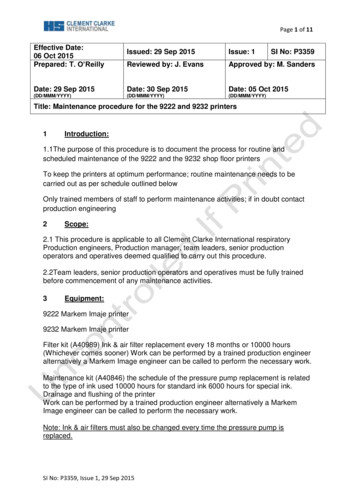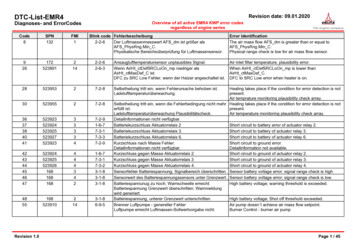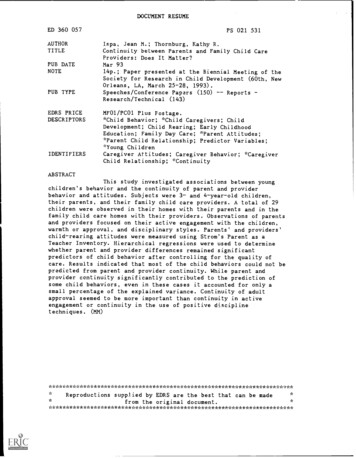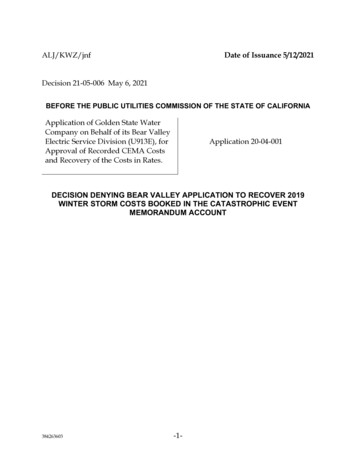
Transcription
ALJ/KWZ/jnfDate of Issuance 5/12/2021Decision 21-05-006 May 6, 2021BEFORE THE PUBLIC UTILITIES COMMISSION OF THE STATE OF CALIFORNIAApplication of Golden State WaterCompany on Behalf of its Bear ValleyElectric Service Division (U913E), forApproval of Recorded CEMA Costsand Recovery of the Costs in Rates.Application 20-04-001DECISION DENYING BEAR VALLEY APPLICATION TO RECOVER 2019WINTER STORM COSTS BOOKED IN THE CATASTROPHIC EVENTMEMORANDUM ACCOUNT384263603-1-
A.20-04-001 ALJ/KWZ/jnfTABLE OF CONTENTSTitlePageDECISION DENYING BEAR VALLEY APPLICATION TO RECOVER 2019WINTER STORM COSTS BOOKED IN THE CATASTROPHIC EVENTMEMORANDUM ACCOUNT .1Summary .21. Background .22. Issues Before the Commission .52.1. Standard of Review .62.2. CEMA Rationale .72.3. Procedural Compliance Met .102.4. Incrementality .112.4.1. Prior CEMA Decisions Support Evaluation of O&M Accounts.132.4.2. Bear Valley Misrepresents the Incremental Requirement .142.4.3. Bear Valley Answer Insufficient in Response to Request to ProvideEvidence Supporting Its Claim of Incrementality.172.4.4. Public Advocates Office Reliance on Spending Is an InsufficientMethod To Find Costs Are Not Incremental .183. Remaining Scoped Items Moot Until Bear Valley Meets Its Burden .194. Exhibits Received Into Evidence .195. Conclusion .206. Comments on Proposed Decision .207. Assignment of Proceeding .20Findings of Fact .20Conclusions of Law .22ORDER .24-i-
A.20-04-001 ALJ/KWZ/jnfDECISION DENYING BEAR VALLEY APPLICATION TO RECOVER 2019WINTER STORM COSTS BOOKED IN THE CATASTROPHIC EVENTMEMORANDUM ACCOUNTSummaryBear Valley Electric Service, Inc.1 (Bear Valley) met all but one key criterionto approve their request to surcharge customers 453,000 for costs incurred in theaftermath of a 2019 winter storm. The rules governing Catastrophic EventMemorandum Account (CEMA) cost recovery require costs be incremental, toavoid charging ratepayers a second time for costs that may already be built intoregular rates. In 2019, Bear Valley spent 11.8 million yet charged rates based onauthorized costs of 14 million. While we find Bear Valley’s CEMA costsreasonable, Bear Valley failed to meet its burden to also prove the costsincremental, instead advancing a concept of CEMA costs as inherentlyincremental. Bear Valley’s application is denied.1.BackgroundOn February 21, 2019, Governor Newsom proclaimed a state of emergencyin 21 of California’s 58 counties due to severe winter storms with beginning datesof January 5, 2019 and February 12, 2019. According to Bear Valley ElectricCompany, Inc. (Bear Valley), it was early on February 14, 2019, when over6 inches of rain fell over a 6-hour period, and gusts of wind reaching 70 miles perhour, and Bear Valley’s electric system infrastructure sustained significantdamage. The damage included 12 downed poles, 25 – 30 downed trees, andcaused outages to at least 9,500 customers that took Bear Valley crews andPursuant to California Public Utilities Commission Decision 19-12-039, Bear Valley ElectricService, Inc. received the electric assets from Golden State Water Company’s Division of BearValley Electric Service and commenced operations July 1, 2020, thus assuming responsibility forthe instant application as Bear Valley Electric Service, Inc.1-2-
A.20-04-001 ALJ/KWZ/jnfoutside contracted crews eighty hours working round-the-clock until servicecould be restored to all customers.2 On March 1, 2019, Bear Valley properlynotified the California Public Utilities Commission (Commission) it wasactivating its Catastrophic Event Memorandum Account (CEMA) account.3 TheCommission approved Bear Valley’s Advice Letter filing 361-E on April 6, 2019,which established the effective date of the 2019 CEMA as January 5, 2019,consistent with the Governor’s proclamation.Bear Valley filed Application (A.) 20-04-001, citing compliance with PublicUtilities Code Section 459.4,4 Commission Resolution E-3238, and Article 2 andRule 3.2 of the Commission’s Rules of Practice and Procedure. With itsApplication, Bear Valley served testimony and requested Commission approvalto recover 444,842 associated with repairs and restoration of service booked intoits 2019 CEMA from February 14, 2019 to March 30, 2019. Bear Valley alsorequested recovery of ancillary costs such as accrued interest and a residualbalance from a 2010 CEMA, bringing the total request for recovery to 469,002.The Public Advocates Office timely filed a protest on May 8, 2020, raisingconcerns about the reasonableness of the costs incurred in Bear Valley’s2019 CEMA as well as the accounting and proposed method of recovery. Atelephonic prehearing conference (PHC) was held on May 29, 2020, to addressthe issues of law and fact, determine the need for hearing, set the schedule forresolving the matter, and address other matters as necessary. At the PHC, thePublic Advocates Office requested the schedule extend intervenor testimony2BVES-001 at 3-5.3Bear Valley Application (A.) 20-04-001 at 3.4All statutory references are to the Public Utilities Code, unless otherwise stated.-3-
A.20-04-001 ALJ/KWZ/jnfuntil September in order to provide adequate time for discovery and audit, andthe Applicant concurred with the request.5After conducting discovery and analysis on Bear Valley’s showing, thePublic Advocates Office served a report on September 14, 2020, in which itrecommended denying Bear Valley’s entire request for recovery on the basis thatthe 2019 storm costs were not incremental and the ancillary requests unmerited.Bear Valley’s rebuttal testimony cited and interpreted the Commission’sauthorities and prior decisions resolving CEMA applications, arguing that once adisaster is declared and the Commission approves the activation of the CEMA,the costs recorded in the CEMA are definitionally excluded from the generalratemaking process because they are in the CEMA account.In response to a joint request to postpone hearings to allow time forsettlement discussions, the ALJ temporarily suspended hearings. OnOctober 30, 2020, the parties filed a joint report, notifying the Commission thatBear Valley was withdrawing its request to recover the residual amounts from2010. The total costs remaining at issue are 452,607 and no material factualissues are in dispute. The assigned Administrative Law Judge (ALJ) cancelledevidentiary hearings and the parties filed briefs on schedule. The parties’ briefscenter on a single legal issue, how to interpret and apply the Commission’srequirement that costs be incremental; specifically whether this requires CEMAcosts be examined relative to overall costs authorized by the Commission forrecovery through the general ratemaking process, when the Commission setsrates through general rate cases (GRC) on the basis of test year forecasts.5Transcript of the PHC, at 11:15-19.-4-
A.20-04-001 ALJ/KWZ/jnf2.Issues Before the CommissionThe Assigned Commissioner’s Scoping Memo and Ruling (Scoping Memo)issued in this proceeding identified the main question as whether theCommission should approve for recovery Bear Valley’s costs booked into theCEMA, including all carrying costs.The scoping questions divide the main question into parts prescribed bythe legal authorities governing CEMA recovery: Commission Resolution E-3238,adopted in 1991 for public utilities, and the California Legislature’s subsequentaffirmation of Resolution E-3238 in 1994, when it added Section 454.9 to thePublic Utilities Code:6(a) The commission shall authorize public utilities to establishcatastrophic event memorandum accounts and to recordin those accounts the costs of the following: (1) Restoringutility services to customers. (2) Repairing, replacing, orrestoring damaged utility facilities. (3) Complying withgovernmental agency orders in connection with eventsdeclared disasters by competent state or federalauthorities.(b) The costs, including capital costs, recorded in the accountsset forth in subdivision (a) shall be recoverable in ratesfollowing a request by the affected utility, a commissionfinding of their reasonableness, and approval by thecommission. The commission shall hold expeditedproceedings in response to utility applications to recovercosts associated with catastrophic events.The legislative mandate is a shortened version of the Commission’sinstruction in Resolution E-3238:The costs eligible for entry into such a memorandum account arethose necessary for: (a) restoring utility service to customers; (b)repairing, replacing or restoring damaged utility facilities; and6Senate Bill (SB) 1456 (1994 Legislative Session (Chapter 1156)).-5-
A.20-04-001 ALJ/KWZ/jnf(c) complying with government agency orders resulting fromdeclared disasters. In addition to direct expenses, utilities could alsobook capital-related costs such as depreciation and return oncapitalized additions. Whether such costs are ultimately recoverablein rates would await a Commission finding of their reasonableness.It is important to stress that authorizing the recording of costsassociated with a disaster should not be construed as a prejudgmentof the appropriateness of recovery of any amounts so accumulated.The purpose of the Commission’s authorizing memorandumaccounts in anticipation is to ensure that these utilities are notprecluded by the retroactive ratemaking prohibition fromrecovering the extraordinary additional costs they may incurimmediately after a disaster but before the Commission can act toauthorize such accounts.The Commission will examine closely all costs recorded in a utility’scatastrophic event memorandum account before allowing theirrecovery in customers’ rates. While costs incurred for repairs maywell be significant, they may not necessarily all be properlyrecoverable from ratepayers. Recovery may be limited byconsideration of the extent to which losses are covered by insurance,the level of loss already built into existing rates, and possibly otherfactors relevant to the particular utility and event. Beforeauthorizing recovery from customers of any costs, the Commissionwill examine how they relate to the overall costs currentlyauthorized for these types of repairs.72.1.Standard of ReviewThe appropriate standard in a ratesetting matter is preponderance of theevidence.8 As the Applicant, Bear Valley bears the burden of proof.Preponderance of the evidence usually is defined “in terms of probability oftruth, e.g., ‘such evidence, when weighed with that opposed to it, has more7Resolution E-3238 at 2-3.8D.16-12-063 at 9, citing D.12-12-030 at 44.-6-
A.20-04-001 ALJ/KWZ/jnfconvincing force and the greater probability of truth’.”9 In short, Bear Valleymust present more evidence that supports the requested result than wouldsupport an alternative outcome.2.2.CEMA RationaleWe begin with scoping question 4.g. because safety is at the heart of allCEMA requests.a. Are there any safety concerns associated with Bear ValleyElectric’s request for approval of a CEMA recovery?The Commission’s explicit intent in establishing the CEMA was to“remove a potential disincentive to utilities’ prompt response to future declareddisasters.” (Resolution E-3238 at 4/Finding 2.) The potential disincentive theCommission removed was reliance on general regulatory ratemaking. In generalregulatory ratemaking, conducted through GRCs, most costs are authorized andrecovered before the fact, based on forecasts of expected operational conditionsand needs. (Decision (D.) 07-07-041 at 2-6 and D.18-06-029 at 12-13.) Once theperiodic review in the GRC concludes, utility revenue and rates are fixed, withsome exceptions, until the next review. Not all costs and circumstances aresuited to long-term planning and forecasting, the most obvious being restorationafter catastrophic or disastrous events. It was after the Loma Prieta earthquakeon October 17, 1989, that the Commission set up a blanket authorization forCEMA accounts in Resolution E-3238, essentially providing a relief valve to thegeneral, prospective ratemaking mechanism of the GRC by establishing the afterthe-fact ratemaking mechanism now known as CEMA.In this case, Bear Valley prioritized safety. Once the storm struck onFebruary 14, Bear Valley chose to hire several outside contractors, keep crews9D.12-12-030 at 42, aff’d D.15-07-044 at 28-30.-7-
A.20-04-001 ALJ/KWZ/jnfworking around-the-clock and send officials door-to-door when customers couldnot be reached.10 Commission-regulated utilities must have confidence that theCEMA ratemaking mechanism will work as designed, so they don’t think twiceabout incurring extra costs if that is what it takes to keep customers safe. Inregulatory terms, CEMA reduces the risk to the utility of incurring costs beyondwhat was expected.The Commission’s addition of another ratemaking mechanism shifts thebalance of risk away from the utility, and toward ratepayers, for the very reasonthat it is hard to control costs when safety is in the balance. The same diligenceapplied in GRCs should be applied in CEMA applications as we evaluateadherence to the Commission’s conditions around the CEMA review process.The requirement that CEMA costs be incremental, recoverable and reasonablemeans that CEMA should not be used as a substitute for proper maintenance andinvestment that is necessary on an ongoing basis. If the condition of the utilityinfrastructure is not up to par, it is important for the Commission to make thedistinction between well-maintained facilities that could not withstandcatastrophic conditions and facilities with weaknesses exposed by catastrophicconditions.The Commission’s focus on safety planning and spending has sharpenedin the last five years. In February 2016, the Commission updated its SafetyAction Plan and established that the Energy Division would review the spendingon safety-related activities of electric and gas utilities which had been approvedin GRCs. For the large energy utilities, the Energy Division prepared reports andcompliance letters scrutinizing energy utility safety-related work funded in rates,10BVES-001 at 3-4.-8-
A.20-04-001 ALJ/KWZ/jnfboth capital projects and activities booked to Operations and Maintenance(O&M) accounts. The idea was to promote greater Commission oversight in theintervening years between rate cases, in order to understand which planned-forprojects and maintenance activities materialized. The revised rate case plan forenergy utilities, adopted by D.14-12-025, sets new reporting requirements withina risk-based decision-making GRC framework. These requirements were refinedin D.19-04-020 closing the consolidated Safety Model Assessment proceeding(A.15-05-002, et al.) as well as in various GRC decisions. In theory, thisframework is intended to confirm spending choices made through the GRCprocess result in improved safety outcomes.Bear Valley filed its last GRC application (A.) 17-05-004 on May 1, 2017,projecting activities and costs for the test year 2018. The Commission authorizedBear Valley’s GRC mid-year 2019, which set revenues and rates based on the2018 projections for four years, through 2022. Just before the conclusion ofBear Valley’s GRC, in D.19-04-020, the Commission applied similar reportingrequirements within a risk-based decision-making GRC framework to the smallor multi-jurisdictional utilities, including Bear Valley. Accordingly, Bear Valley’sGRC decision, D.19-08-027, implemented the Commission’s sharpened focus onsafety planning and spending:Golden State Water Company, on behalf of its Bear ValleyElectric Service Division, shall file an information-only adviceletter within 60 days of the issuance of the final decision inthis proceeding, and annually by March 31 of each succeedingyear, which includes a comparison of actual expenditures toadopted expenditures as approved in this decision for safety,reliability, and maintenance programs pursuant to thereporting requirements of Decision (D.) 19-04-020 and Public-9-
A.20-04-001 ALJ/KWZ/jnfUtilities Code Section 591 relating to the Risk SpendingAccountability Report.11While the Risk Spending Accountability Report (RSAR) is new, CEMA isdecades old. CEMA conditions, from the beginning, required the Commission toconfirm that CEMA costs are separate and distinct from the costs that wereplanned for, expected, and authorized on a forecast basis in a GRC. Some of theCEMA conditions apply at the time the CEMA is established. For example,when the utility “activates” a CEMA in the immediate aftermath of the event,CEMA conditions specify how and when the utility must notify the Commission.CEMA also requires that an independent authority deem the event anemergency. This decision focuses on the conditions associated with the end ofthe CEMA, when the utility applies to recover the costs in its CEMA. During thereview of costs, the utility must show the costs are different than those costsrecovered through the primary ratemaking mechanism, the GRC.2.3.Procedural Compliance MetParties do not dispute Bear Valley’s compliance with several of theprocedural requirements of CEMA outlined in Resolution E-3238.Scoping Question 4.a.:Did Bear Valley Electric properly and timely establish aCEMA for these events in accordance with Pub. Util. Code§ 454.9 and Resolution E-3238?Scoping Question 4.d.:Are Bear Valley Electric’s accounting method(s) used forbooking in its CEMA reasonable, justified, and consistent withthe law?11D.19-08-027 Ordering Paragraph (OP) 17.-10-
A.20-04-001 ALJ/KWZ/jnfThe Public Advocates Office confirmed that on February 21, 2019, theGovernor of California issued a State of Emergency Proclamation underGovernment Code Section 8558(b), a Commission recognized competentauthority, covering Bear Valley’s service territory for the February 2019 storm.12The Public Advocates Office confirmed that Bear Valley properly established its2019 CEMA account with the filing of Bear Valley Advice Letter 361-E onMarch 6, 2019.13Furthermore, the Public Advocates Office audited the costs booked byBear Valley in its CEMA and did not identify any irregularities.142.4.IncrementalityScoped questions 4.c. and 4.b. below, outline the conditions that must bemet to grant CEMA recovery and are key to preserving the integrity of theCEMA review.Scoping Question 4.c.:Whether Bear Valley Electric’s total CEMA cost, including theresidual amount from the 2010 CEMA, is incremental,reasonable and recoverable?Scoping Question 4.b.:Are the costs for which Bear Valley Electric seek
Company on Behalf of its Bear Valley Electric Service Division (U913E), for Approval of Recorded CEMA Costs and Recovery of the Costs in Rates. Application 20-04-001 DECISION DENYING BEAR VALLEY APPLICATION TO RECOVER 2019 WINTER STORM
